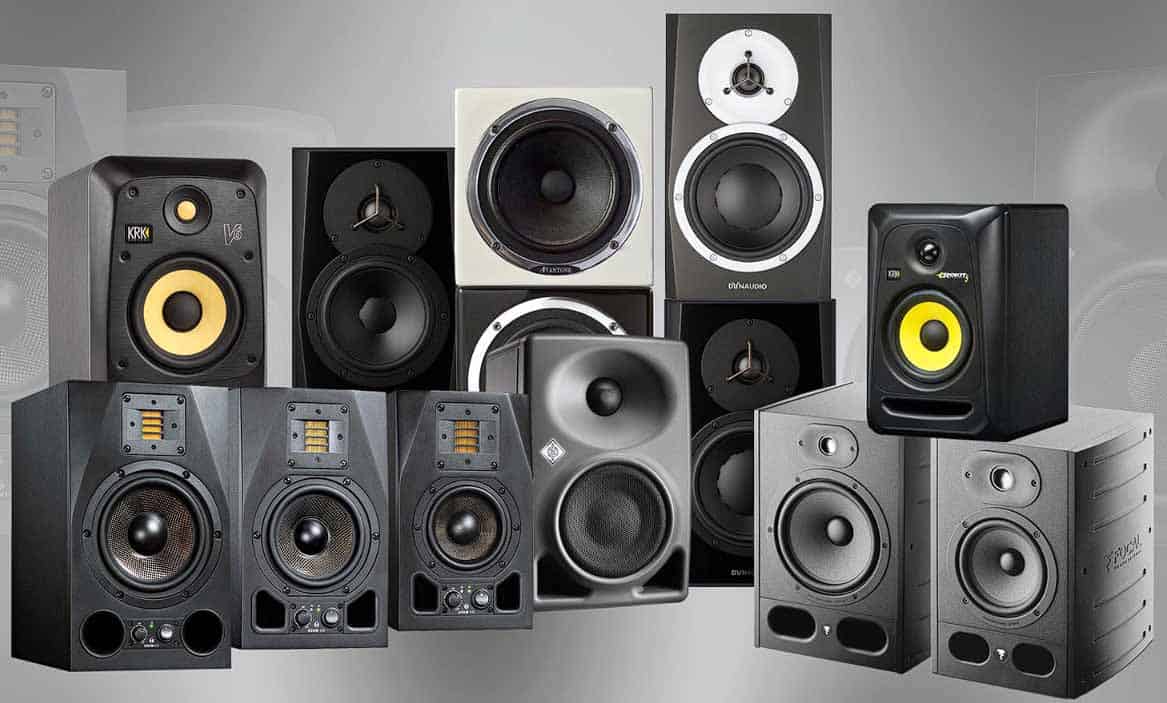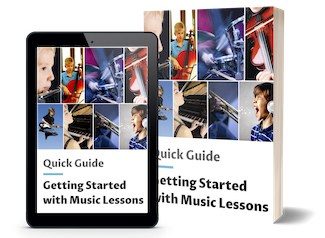Creating great music doesn’t have to drain your bank account, especially when it comes to monitor speakers. I’ve spent years testing budget-friendly options, and I’m excited to share that you can find excellent monitor speakers for under $500 that deliver professional-quality sound for home studios and music production.
The best affordable monitor speakers, like the Adam Audio T5V and Kali Audio LP-6 V2, offer flat frequency response and accurate sound reproduction without the premium price tag. These speakers prove that you don’t need to spend thousands to get honest, uncolored audio that helps your mixes translate well across different playback systems.
In this guide, I’ll walk you through everything you need to know about choosing affordable monitor speakers. We’ll explore the key features that matter most, dive into top models from trusted brands, and cover essential setup tips to help you make the best decision for your music-making journey.
Key Features of the Best Affordable Monitor Speakers
Good affordable monitors share specific features that make them worth your money. I focus on flat response, adequate power, flexible connections, and helpful tuning controls when choosing budget speakers.
Flat Frequency Response Explained
A flat frequency response means the speakers play all frequencies at equal volumes. This gives me an honest picture of what my mix actually sounds like.
Budget monitors like the Kali Audio LP-6 V2 achieve impressive flatness for around $400. The Adam Audio T5V also delivers balanced sound across most frequencies.
What to look for:
- Response curves with minimal peaks and dips
- Range from at least 50Hz to 20kHz
- Slight variations are normal in budget models
I don’t expect perfect flatness at low prices. Small bumps around 2-4kHz are common and manageable.
Most affordable monitors have some coloration. The key is finding speakers with predictable, minimal deviations that I can learn to work with.
Mackie CR3-X 3 inch Multimedia Monitors
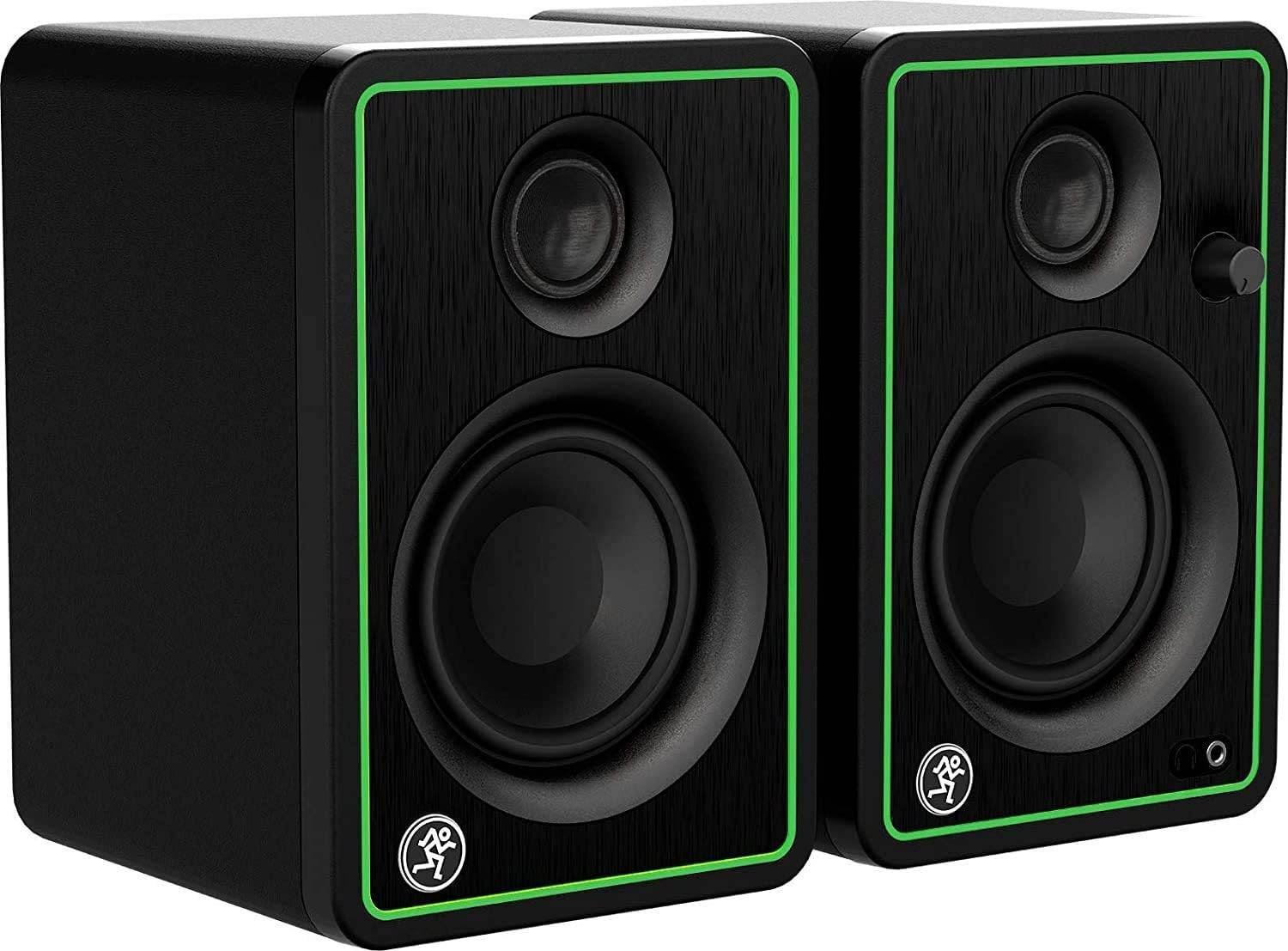
FEATURES: Desktop monitor speakers with 3" drivers
OTHER INFO: Convenient front-panel volume control and headphone output
- Includes speaker cable, dual RCA stereo cable, and 1/8"-1/8" cable
- Limited low-end response
When you click ‘Check Price’, you’ll see there are loads of great places to buy this item. Our personal favorite is Sweetwater for the US, and Thomann and Gear4Music for the UK & Europe.
They are the largest music retailers, with excellent customer service, competitive prices, really fast shipping, and the longest guarantees.
The professional musician who wrote this article combined many things,
from the product build, manufacturer’s reputation through to feedback
from other users, to create our famous TedScore™.
Power Output and SPL
Power output determines how loud my monitors can play without distortion. I need enough headroom for dynamic material and occasional loud monitoring.
Typical power ranges:
- 3-4 inch monitors: 25-50W per speaker
- 5-6 inch monitors: 50-80W per speaker
- 8 inch monitors: 80-150W per speaker
SPL (Sound Pressure Level) tells me the maximum volume before distortion kicks in. Most budget monitors handle 100-110 dB SPL, which works fine for home studios.
The PreSonus Eris E3.5 delivers 25W per speaker but still provides adequate volume for small rooms. Larger drivers like those in the Kali LP-6 V2 offer 80W and higher SPL capabilities.
I match power to my room size and listening distance. More power gives me cleaner sound at moderate volumes, not just louder playback.
PreSonus Eris 4.5

DESIGNED FOR: Bringing studio-grade audio fidelity even to home studios.
FEATURES: 100dB maximum continuous SPL
PRICE RANGE: £/$170
- Money-back guarantee
- Premium-grade components
- Text
When you click ‘Check Price’, you’ll see there are loads of great places to buy this item. Our personal favorite is Sweetwater for the US, and Thomann and Gear4Music for the UK & Europe.
They are the largest music retailers, with excellent customer service, competitive prices, really fast shipping, and the longest guarantees.
The professional musician who wrote this article combined many things,
from the product build, manufacturer’s reputation through to feedback
from other users, to create our famous TedScore™.
Connectivity Options and Inputs
Multiple input types let me connect different audio sources without adapters. I look for both professional and consumer connections on budget monitors.
Essential connections include:
- XLR: Professional balanced input
- TRS (1/4″): Balanced instrument/line input
- RCA: Unbalanced consumer input
- USB-C: Digital connection (newer models)
The Adam Audio T5V includes XLR and RCA inputs, covering most needs. Budget models often skip digital connectivity to keep costs down.
I prefer monitors with at least two input types. This flexibility helps when switching between audio interfaces, phones, or other sources.
Some ultra-budget models only offer RCA or mini-jack inputs. These work but limit my connection options as my studio grows.
Built-In DSP and Acoustic Controls
Digital signal processing and EQ controls help me tune monitors to my room. These features were once expensive but now appear on many budget models.
Common acoustic controls:
- High-frequency trim: Adjusts tweeter level
- Low-frequency trim: Controls bass response
- Boundary EQ: Compensates for wall placement
The Kali LP-6 V2 offers eight boundary EQ settings via DIP switches. This lets me optimize response based on monitor placement.
Basic graphic EQ or simple high/low adjustments work well for room correction. I don’t need complex DSP on budget monitors.
These controls help compensate for room acoustics and personal preferences. Even simple +/- 2dB adjustments make noticeable differences in sound quality.
Top Affordable Monitor Speaker Models and Brands
Several standout models dominate the budget studio monitor market, each offering unique strengths for home recording. The KRK Rokit 5 brings exciting bass response, while the Yamaha HS5 delivers bright detail that requires careful mixing adjustments.
KRK Rokit RP5
The KRK Rokit RP5 has earned its place as one of the most recognizable budget studio monitors. I’ve noticed these yellow-coned speakers in countless home studios because they offer an exciting, fun listening experience.
These monitors feature a distinctive “scooped” sound with boosted bass and treble. The low end feels punchy and impressive, which makes music sound engaging during long mixing sessions.
However, this exciting sound can be tricky for beginners. Your mixes might end up sounding thin and lacking bass when played on other systems.
Key Features:
- 5-inch woofer with yellow Kevlar cone
- 50 watts of power
- Front-firing bass port
- Built-in EQ adjustments
The newer G5 version offers better neutrality than earlier models. I recommend these monitors for producers who want inspiring playback but are willing to learn their sound signature well.
KRK ROKIT RP5 G5
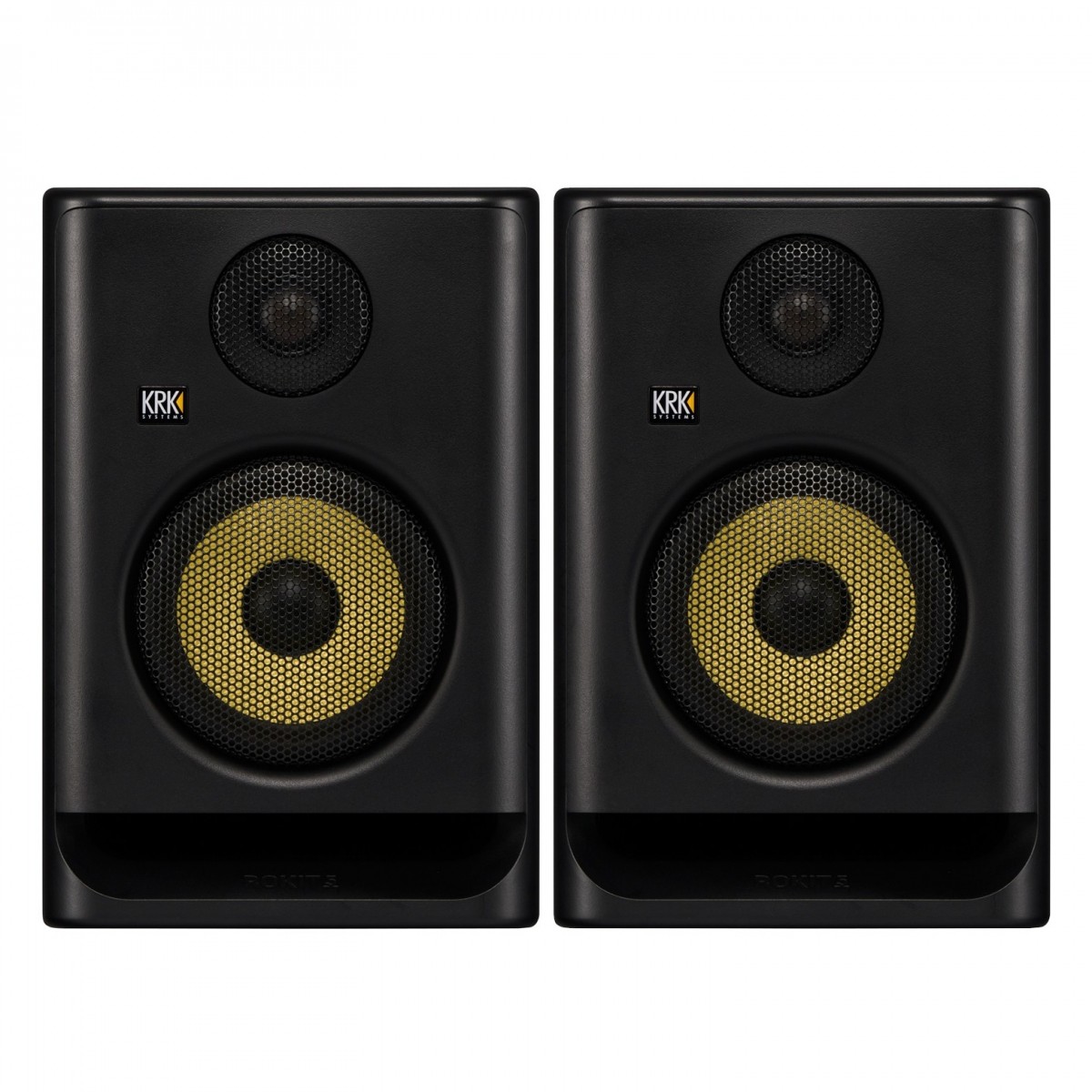
DESIGNED FOR: Music producers, DJs, and recording artists of all levels
FEATURES: 5” woofer with advanced DSP-driven room tuning
OTHER INFO: The G5 model builds on KRK’s legacy with improved clarity, punchy low-end, and onboard EQ adjustments for any space.
- Exceptional sound accuracy and balance across frequencies
- Built-in DSP room correction with visual LCD interface
- Requires proper placement for optimal performance
When you click ‘Check Price’, you’ll see there are loads of great places to buy this item. Our personal favorite is Sweetwater for the US, and Thomann and Gear4Music for the UK & Europe.
They are the largest music retailers, with excellent customer service, competitive prices, really fast shipping, and the longest guarantees.
The professional musician who wrote this article combined many things,
from the product build, manufacturer’s reputation through to feedback
from other users, to create our famous TedScore™.
Yamaha HS5
The Yamaha HS5 looks similar to the famous NS-10 studio monitors but sounds completely different. I often hear mixes that were created on these speakers, and they tend to share common problems.
These monitors have a bright, detailed upper midrange that sounds impressive at first. The tight, present sound makes you feel like you’re hearing every detail in your mix.
Unfortunately, this brightness often leads to dull, muddy mixes. Your brain compensates for the bright monitors by making darker-sounding music.
Common HS5 Mix Problems:
- Boomy low end
- Boxy midrange
- Dull upper mids
- Harsh high frequencies
The HS5 can work well if you learn to mix much brighter than what sounds good on the speakers. Many successful producers use them, but it requires experience and careful reference checking.
Yamaha HS5

DESIGNED FOR: Home producers
COMES WITH: Standard monitor
FEATURES: Great for all kinds of music
- Affordable
- Bi amplified
- Near field monitor
- No woofer included
When you click ‘Check Price’, you’ll see there are loads of great places to buy this item. Our personal favorite is Sweetwater for the US, and Thomann and Gear4Music for the UK & Europe.
They are the largest music retailers, with excellent customer service, competitive prices, really fast shipping, and the longest guarantees.
The professional musician who wrote this article combined many things,
from the product build, manufacturer’s reputation through to feedback
from other users, to create our famous TedScore™.
JBL 305P MkII and 1 Series 104-BT
JBL’s budget monitors offer surprising quality for their low price point. The 305P MkII delivers professional sound that punches well above its weight class.
These 5-inch monitors feature JBL’s waveguide technology for better stereo imaging. The sound signature has a slight smile curve with enhanced bass and treble.
I find the JBL 305P MkII less extreme than other “hyped” monitors. They provide some excitement without going overboard on coloration.
The smaller 104-BT desktop monitors include Bluetooth connectivity. These 4-inch speakers work great for small spaces or as secondary reference monitors.
JBL Advantages:
- Excellent build quality
- Professional waveguide design
- Balanced sound signature
- Great value pricing
Both models offer reliable performance for home studio work. The 305P MkII works better for serious mixing, while the 104-BT suits casual production and desktop setups.
JBL 104-BT Bluetooth Reference Monitor
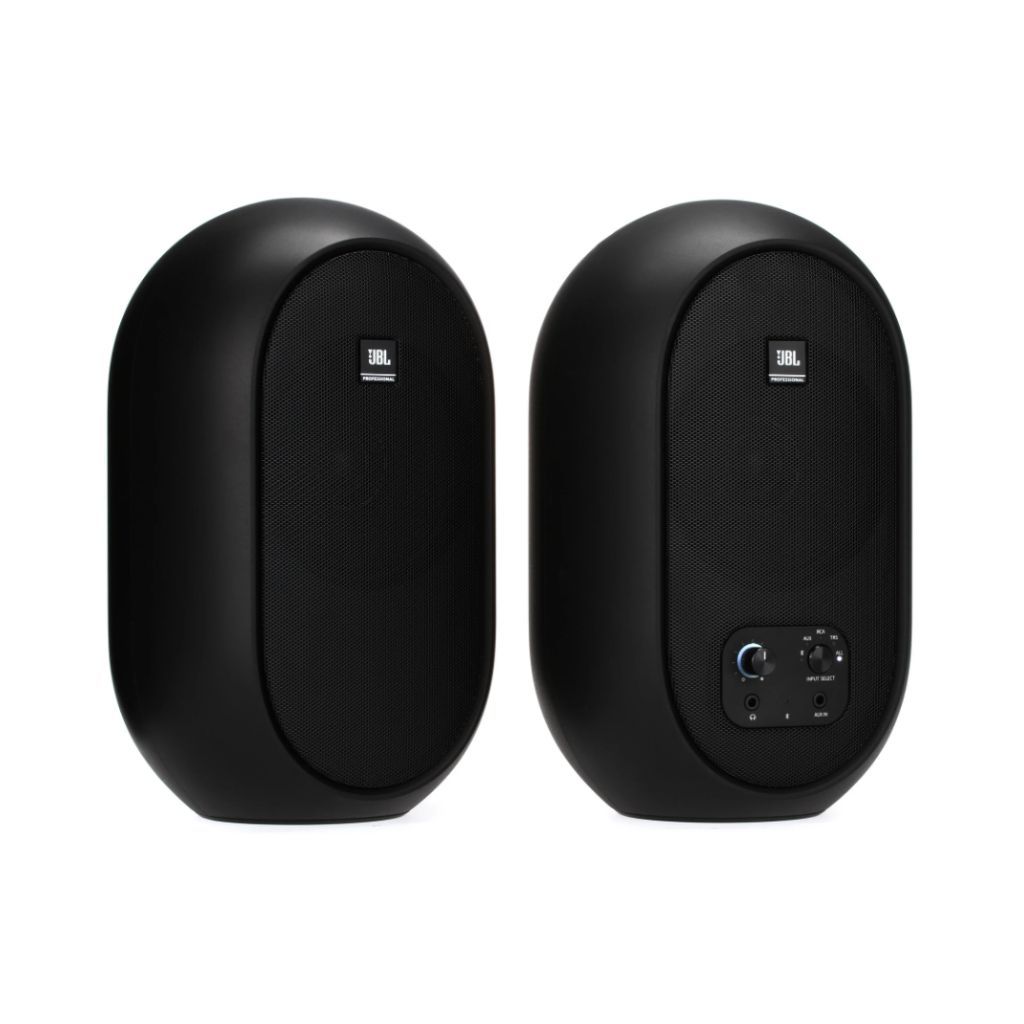
FEATURES: Innovative coaxial driver design and contoured low-frequency port
OTHER INFO: 4.5" low-frequency transducer and .75" high-frequency transducer
- Bluetooth 5.0 compatible for streaming reference mixes
- Sturdy ABS enclosure with metal grill
- Potential latency issues
When you click ‘Check Price’, you’ll see there are loads of great places to buy this item. Our personal favorite is Sweetwater for the US, and Thomann and Gear4Music for the UK & Europe.
They are the largest music retailers, with excellent customer service, competitive prices, really fast shipping, and the longest guarantees.
The professional musician who wrote this article combined many things,
from the product build, manufacturer’s reputation through to feedback
from other users, to create our famous TedScore™.
Mackie CR3 and CR4-X
Mackie’s CR series targets entry-level producers with extremely affordable pricing. The CR3 and CR4-X provide basic studio monitoring without breaking your budget.
These monitors feature simple designs with front-panel volume controls and headphone outputs. The CR4-X adds Bluetooth connectivity for wireless streaming from phones and tablets.
I consider these speakers stepping stones rather than long-term solutions. They work fine for learning basic mixing concepts but lack the accuracy needed for professional work.
The sound quality feels adequate for the price but doesn’t compete with slightly more expensive options. You’ll hear decent detail and reasonable frequency balance.
Mackie CR Series Features:
- Ultra-budget pricing
- Simple operation
- Headphone outputs
- Bluetooth on CR4-X model
These monitors make sense if your budget is extremely tight. However, I’d recommend saving a bit more for better options like the JBL or PreSonus models if possible.
Understanding Monitor Speaker Components
Monitor speakers have three main parts that work together to create good sound reproduction. The woofer handles bass sounds, the tweeter makes high sounds clear, and the crossover splits the audio signal between them.
Woofer and Bass Performance
The woofer is the bigger speaker cone that makes bass and mid-range sounds. I find that woofer size really matters for the kind of bass you’ll get from your monitors.
Smaller woofers around 3 to 5 inches work well for tight, punchy bass in small rooms. They don’t take up much desk space and give you clear mid-range sounds for voices and instruments.
Larger woofers from 6 to 8 inches can move more air and create deeper bass. These work better if you have a bigger room or want more low-end power for your music.
The material of the woofer cone affects how it sounds. Paper cones give warm, natural sound but can wear out faster. Composite materials like woven fibers offer better durability and tighter bass response.
Most budget monitors use composite woofers because they last longer and sound more accurate.
Woofer and Bass Performance
Tweeters are the small speakers that handle high-frequency sounds like cymbals and vocal details.
The type of tweeter changes how crisp and smooth these high sounds will be.
Silk dome tweeters are very popular in budget monitors. They create smooth, warm high frequencies that don’t sound harsh or bright. I really like silk dome tweeters because they’re easy on your ears during long listening sessions.
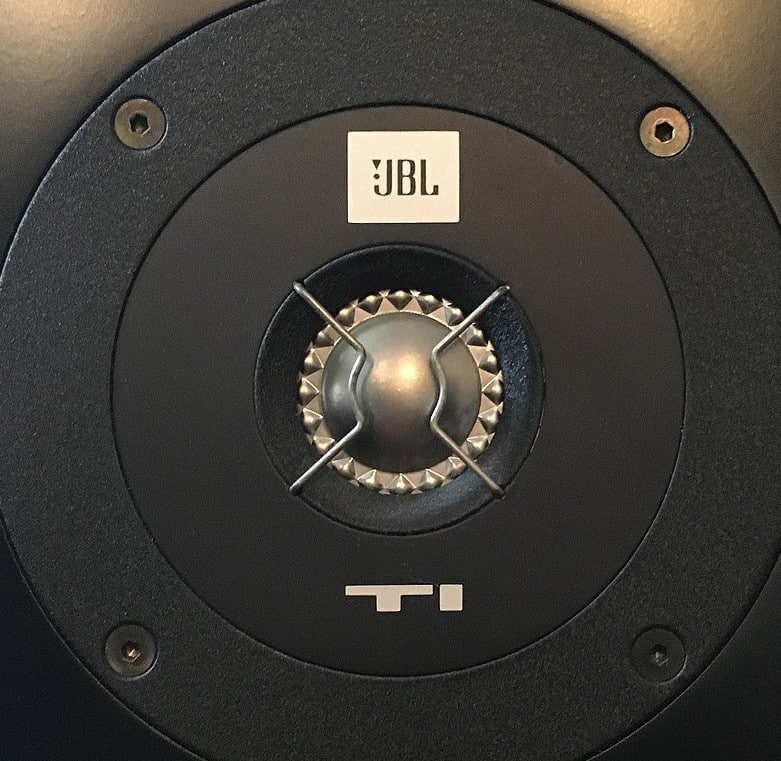
Metal dome tweeters sound brighter and more detailed. They can reveal more information in your recordings but might sound too sharp for some people.
Ribbon tweeters are less common in budget speakers but offer very detailed highs. The tweeter’s job is crucial for hearing things like reverb tails and the sparkle in your mix.
Crossover Design
The crossover is like a traffic director that sends low frequencies to the woofer and high frequencies to the tweeter. Good crossover design makes sure both drivers work together smoothly.
Simple crossovers in budget monitors usually split the signal around 2,000 to 3,000 Hz. This means the woofer handles everything below that point while the tweeter takes care of higher sounds.
Poor crossover design can create gaps in the frequency response. This makes some sounds louder or quieter than they should be, which hurts your ability to mix accurately.
Better budget monitors use quality capacitors and components in their crossovers. These help create a smoother transition between the woofer and tweeter for more natural sound reproduction.
Performance Factors for Music Production and Mixing
Several key factors determine how well budget monitors will serve your music production needs. The most critical elements include sound accuracy, frequency response quality, mastering capabilities, and speaker size considerations for your workspace.
Accurate Sound Reproduction for Mixing
Accurate sound reproduction forms the foundation of successful mixing work. Your monitors need to reveal exactly what’s happening in your mix without adding their own color or character to the sound.
I’ve found that the best affordable monitors deliver what we call “transparent” sound. This means they don’t boost certain frequencies or hide problems in your mix. When your monitors are accurate, you can trust the mixing decisions you make.
Key accuracy features to look for:
- Flat frequency response across the spectrum
- Low self-noise that won’t interfere with quiet details
- Wide sweet spot for consistent sound when you move around
The Adam Audio T5V and Kali LP-6 V2 excel in this area. They both provide honest sound reproduction that helps music producers make better mixing choices.
Accurate monitoring prevents the common problem of mixes that sound great in your studio but terrible everywhere else. When your monitors tell the truth, your mixes translate well to car stereos, headphones, and streaming platforms.
Importance of Frequency Response
Accurate sound reproduction forms the foundation of successful mixing work. Your monitors need to reveal exactly what’s happening in your mix without adding their own color or character to the sound.
I’ve found that the best affordable monitors deliver what we call “transparent” sound.
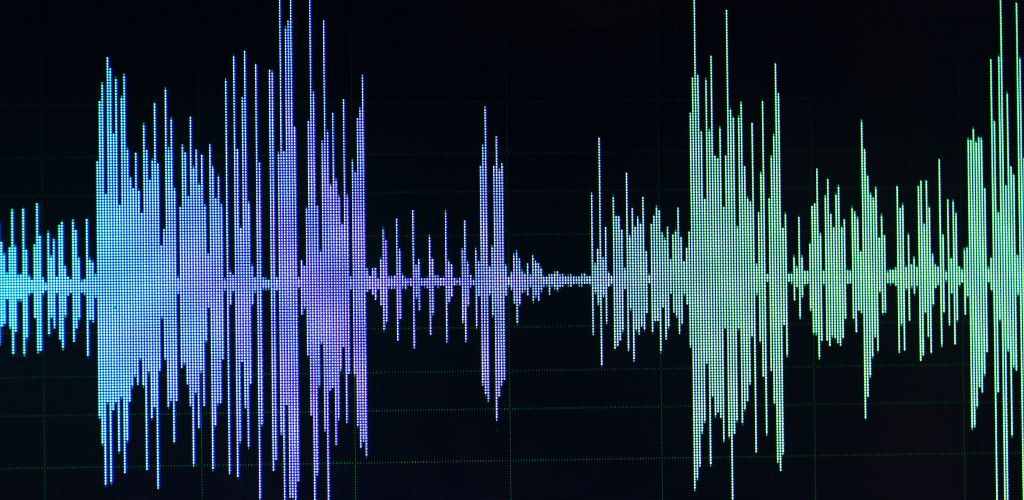
This means they don’t boost certain frequencies or hide problems in your mix. When your monitors are accurate, you can trust the mixing decisions you make.
Key accuracy features to look for:
- Flat frequency response across the spectrum
- Low self-noise that won’t interfere with quiet details
- Wide sweet spot for consistent sound when you move around
The Adam Audio T5V and Kali LP-6 V2 excel in this area. They both provide honest sound reproduction that helps music producers make better mixing choices.
Accurate monitoring prevents the common problem of mixes that sound great in your studio but terrible everywhere else. When your monitors tell the truth, your mixes translate well to car stereos, headphones, and streaming platforms.
Monitoring for Mastering
Mastering requires even more accuracy than mixing since you’re making final adjustments that affect the entire song. Your monitors need to reveal subtle details and provide excellent stereo imaging.
For mastering work on a budget, I recommend larger drivers when possible. The 6.5-inch drivers in the Kali LP-6 V2 provide better low-end accuracy than smaller 3.5-inch speakers.
Mastering monitor requirements:
- Extended frequency response, especially in the low end
- Excellent stereo imaging and soundstage
- Low distortion at moderate listening levels
- Ability to reveal compression artifacts and EQ changes
Many music producers use their mixing monitors for mastering too. While dedicated mastering monitors exist, good mixing monitors like the Adam Audio T5V can handle both tasks effectively.
The key is learning your monitors’ characteristics. Once you understand how your monitors sound, you can compensate for their limitations during the mastering process.
Monitoring for Mastering
Your room size determines which monitor size will work best for your setup. Smaller rooms often benefit from compact designs, while larger spaces can handle bigger drivers.
The PreSonus Eris E3.5 works perfectly in bedroom studios or tight desk setups. These compact monitors won’t overwhelm small spaces with too much bass energy.
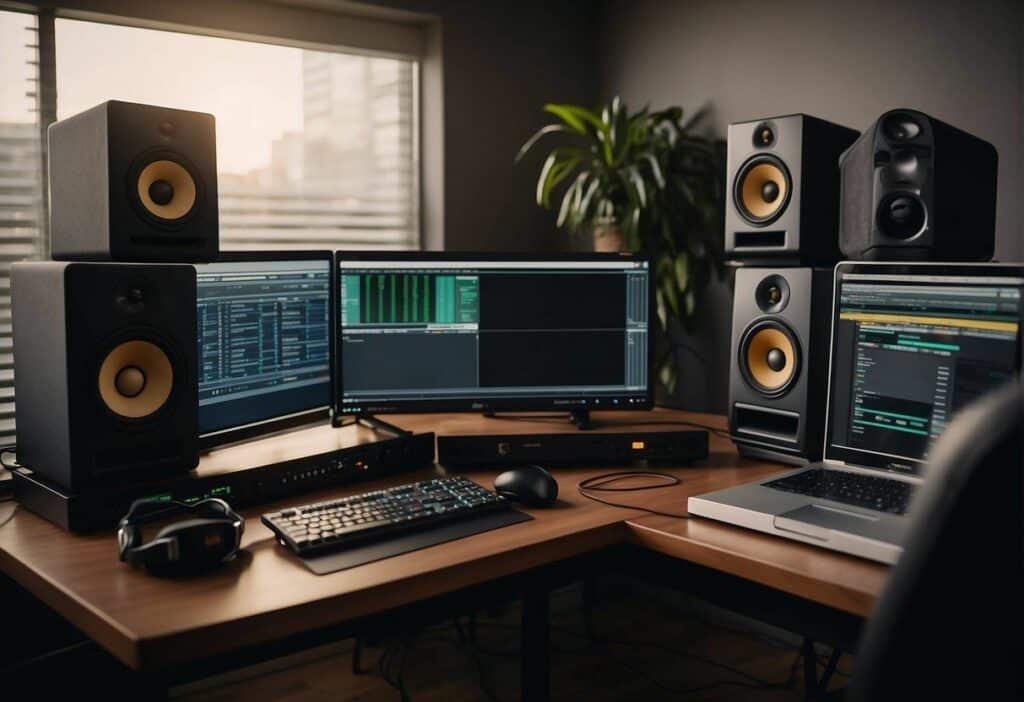
Room size guidelines:
- Small rooms (under 100 sq ft): 3-4 inch monitors
- Medium rooms (100-200 sq ft): 5-6 inch monitors
- Larger rooms (200+ sq ft): 6+ inch monitors
I’ve noticed that placing monitors too close to walls can cause bass buildup. Front-ported designs like the Kali LP-6 V2 handle near-wall placement better than rear-ported models.
Compact design also affects your listening position. Smaller monitors typically need to be placed closer to your ears for optimal sound. This creates a more intimate monitoring environment that many music producers prefer for detailed work.
Build Quality and Durability
When I look at budget studio monitors, I focus on two main things: the materials used to build them and how long they’ll actually last. Active monitors in this price range can still offer solid construction if you know what to look for.
Cabinet Materials and Construction
Most affordable active monitors use MDF (Medium Density Fiberboard) for their cabinets. This material works well because it reduces unwanted vibrations that can mess up your sound.
I’ve noticed that better budget monitors have thicker cabinet walls. Thin walls create more vibration and weaker bass response.
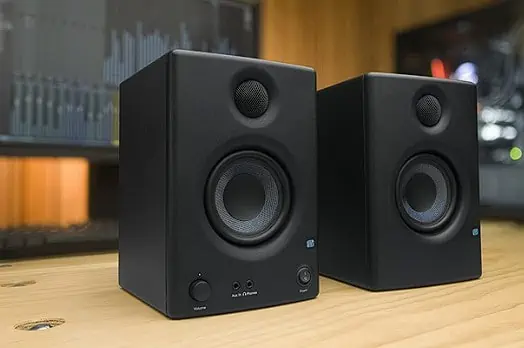
Look for monitors with reinforced internal bracing. These extra supports inside the cabinet stop the walls from flexing when the speakers play loud.
The front baffle should feel solid when you tap it. A well-built baffle keeps the drivers properly aligned and reduces distortion.
Port design matters too. Cheaper monitors sometimes have rough or poorly shaped ports that create unwanted noise.
Good budget monitors also have quality binding posts or input connectors. Flimsy connections can cause crackling sounds or complete failure over time.
Longevity of Budget Studio Monitors
I expect budget active monitors to last 3-5 years with regular home studio use. Heavy commercial use might cut that time shorter.
The amplifiers built into active monitors are often the first things to fail. Look for brands that offer repair services or warranty support.
Driver deterioration happens slowly over time. The foam surrounds on woofers can crack after several years, especially in humid conditions.
Heat management affects durability a lot. Monitors with proper ventilation and heat sinks last longer than ones that run hot.
Regular cleaning helps extend life. Dust buildup can damage internal components and affect cooling.
I recommend buying from established brands because they typically use better internal components. Unknown brands might save money by using cheaper capacitors or amplifier chips that fail sooner.
Essential Setup and Connectivity Tips
Getting your affordable monitor speakers connected properly makes all the difference in sound quality. I’ll walk you through the best connection types and setup methods to get professional results without breaking the bank.
Balanced Connections: XLR and TRS
XLR and TRS connections are your best friends for clean, professional audio. These balanced cables reject noise and interference much better than basic RCA or 3.5mm connections.
XLR cables use three pins to carry audio signals. The design cancels out electrical noise that can sneak into your audio chain.
TRS cables look like thick headphone plugs with two black rings. They work the same way as XLR but in a different shape.
Most affordable monitor speakers come with both XLR and TRS inputs. This gives you flexibility when connecting different audio sources.
I always recommend using balanced cables when possible. The difference in sound clarity is noticeable, especially in home studios or quiet listening environments.
Cable lengths matter too. Stick to 6-10 feet for most setups to avoid signal loss.
TRS 3.5mm Jack to TRS 3.5mm Jack Pro Cable
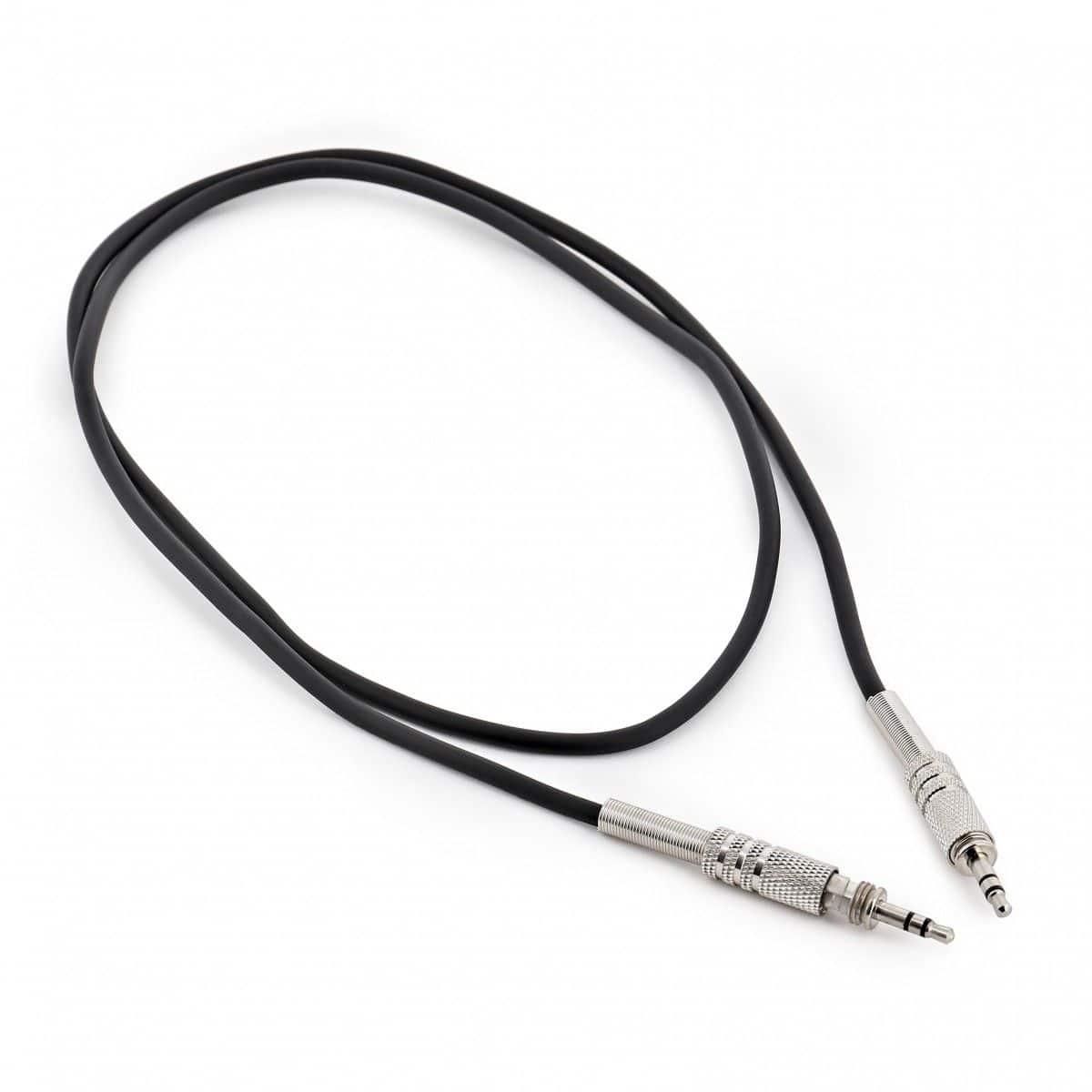
FEATURES: 1m / 3.3ft length
OTHER INFO: 3.5mm / 1/8in TRS Jack - 3.5mm / 1/8in TRS Jack
- Replicates a full frequency response of any source with maximum dynamic range
- Not well-suited for locking mechanisms compared to some other connector types
When you click ‘Check Price’, you’ll see there are loads of great places to buy this item. Our personal favorite is Sweetwater for the US, and Thomann and Gear4Music for the UK & Europe.
They are the largest music retailers, with excellent customer service, competitive prices, really fast shipping, and the longest guarantees.
The professional musician who wrote this article combined many things,
from the product build, manufacturer’s reputation through to feedback
from other users, to create our famous TedScore™.
Integrating Audio Interfaces
An audio interface acts as the bridge between your computer and monitor speakers. Skip the headphone output on your computer – it won’t give you the best sound quality.
Popular budget interfaces like the Focusrite Scarlett series work great with affordable monitors. They provide clean balanced outputs and volume control.
Connect your interface to speakers using the same balanced cables I mentioned above. Most interfaces have 1/4-inch TRS outputs that match your speaker inputs perfectly.
Here’s my setup process:
- Turn speaker volumes all the way down first
- Connect cables with everything powered off
- Set interface volume to halfway
- Slowly bring up speaker volume to comfortable levels
This prevents loud pops or damage to your speakers. Always start quiet and work your way up.
Bluetooth and Modern Features
Many new affordable monitors include Bluetooth connectivity for wireless convenience. This feature works great for casual listening and streaming music from your phone.
Bluetooth quality has improved dramatically in recent years. Modern codecs like aptX provide surprisingly good sound for wireless connections.
Wired still wins for serious work. I use Bluetooth for background music but switch to balanced cables when mixing or critical listening.
Some budget monitors also include USB inputs for direct computer connection. These can sound better than your computer’s built-in audio but won’t match a dedicated audio interface.
Look for speakers with multiple input options. Having both wired and wireless choices gives you the most flexibility for different situations.
FAQ's
The Adam Audio T5V stands out as my top pick for overall value. These monitors cost around $350 for a pair and deliver crystal-clear sound with great connectivity options.
For serious mixing work, I recommend the Kali Audio LP-6 V2. They offer amazing transparency and neutral sound for about $400 per pair.
The PreSonus Eris E3.5 monitors are perfect if you need the cheapest option. You can get a pair for under $100, and they still sound fantastic for the price.
I think the Kali Audio LP-6 V2 gives you the best mixing performance for the money. Their flat frequency response and low self-noise make them ideal for accurate mixing work.
The 6.5-inch drivers provide excellent clarity across all frequencies. The built-in boundary EQ settings help you tune them to your specific room.
If you can spend a bit more, the Adam Audio T5V also works great for mixing. The ribbon tweeter delivers superb high-end detail that helps your mixes shine.
Yes, the PreSonus Eris E3.5 monitors deliver surprising quality for under $100 per pair. They use Kevlar drivers and include useful EQ tuning options.
These compact monitors work well for detailed mixing work despite their small size. The soundstage is wide and clear, which helps you position elements in your mix.
While they can’t match larger monitors for low-end response, they’re perfect for tight budgets. I consider them an excellent upgrade from laptop speakers or basic headphones.
The Adam Audio T5V works excellently for guitar recording and mixing. The clear high-end response helps you hear pick attack and string details clearly.
For guitarists who need compact monitors, the PreSonus Eris E3.5 fits perfectly on small desks. They reproduce guitar frequencies well despite their 3.5-inch drivers.
The Kali Audio LP-6 V2 also suits guitarists who mix their own recordings. Their neutral sound helps you make guitar tracks that translate well to other systems.
Look for front-ported designs that let you place monitors close to walls. The Kali Audio LP-6 V2 uses front ports, making them perfect for small rooms.
Choose monitors with multiple input options like XLR, TRS, and RCA connections. This flexibility helps you connect different audio interfaces and devices easily.
Consider monitors with built-in EQ controls for room tuning. Boundary EQ settings help you adjust the sound based on your monitor placement.
The Yamaha HS5 monitors offer good build quality and reliable performance for home studios. They’re known for their honest, uncolored sound reproduction.
However, I prefer the Adam Audio T5V for similar money because of their superior ribbon tweeter. The T5V delivers better high-frequency detail and imaging.
The Kali Audio LP-6 V2 also beats the HS5 in my opinion with better low-end response. Their 6.5-inch drivers give you more accurate bass than the HS5’s 5-inch woofers.


